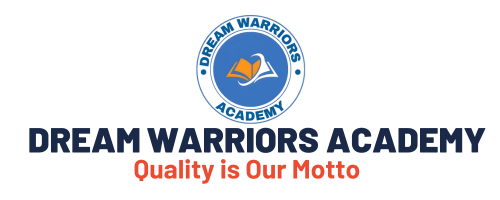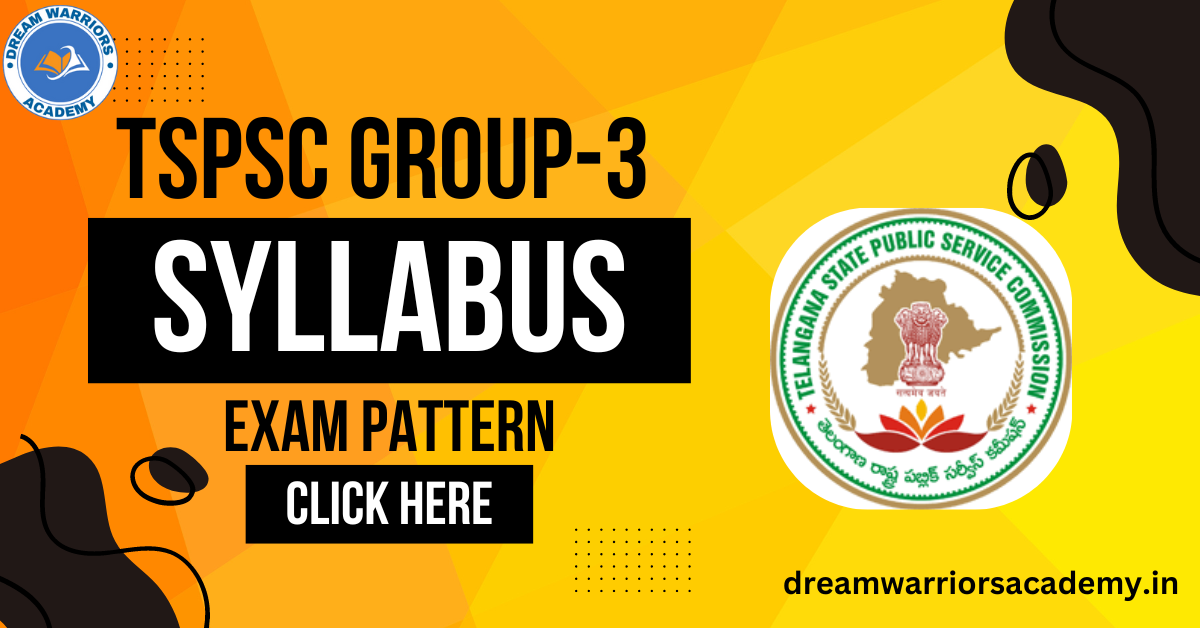TGPSC Group 3 Exam Pattern and Syllabus (Updated):
Telangana state public service commission (TGPSC) conducts TGPSC group 3 examination Telangana state. TGPSC group 3 examination has 3 papers General studies and general abilities History polity and Society Economy and development. The written exam will be conducted in English, Telugu and Urdu

Table of Contents
TGPSC Group 3 Exam Pattern :
| PAPER | SUBJECT | QUESTIONS (MULTIPLE CHOICE) | DURATION (HOURS) | MAXIMUM MARKS |
|---|---|---|---|---|
| Paper- I | GENERAL STUDIES AND GENERAL ABILITIES | 150 | 2 ½ | 150 |
| Paper-II | HISTORY, POLITY AND SOCIETY i. Socio-Cultural History of Telangana ii. Overview of the Indian Constitution and Politics iii. Social Structure, Issues and Public Policies | 150(3×50) | 2 ½ | 150 |
| Paper-III | ECONOMY AND DEVELOPMENT i. Indian Economy: Issues and challenges ii. Economy and Development of Telangana iii. Issues of Development and Change | 150(3×50) | 2 ½ | 150 |
| TOTAL MARKS | 450 |
TGPSC Group 3 Syllabus :
PAPER-I: GENERAL STUDIES AND GENERAL ABILITIES:
- Current Affairs – Regional, National & International.
- International Relations and Events.
- General Science; India’s Achievements in Science and Technology
- Environmental Issues; Disaster Management – Prevention and Mitigation Strategies.
- World Geography, Indian Geography and Geography of Telangana State.
- History and Cultural Heritage of India.
- Society, Culture, Heritage, Arts and Literature of Telangana.
- Policies of Telangana State.
- Social Exclusion, Rights Issues and Inclusive Policies.
- Logical Reasoning; Analytical Ability and Data Interpretation.
- Basic English. ( 10th Class Standard)
PAPER-II HISTORY, POLITY AND SOCIETY:
I. Socio-Cultural History of Telangana and Formation of Telangana State
- Satavahanas, Ikshvakus, Vishnukundins, Mudigonda and Vemulawada Chalukyas and their contribution to culture; Social and Religious conditions; Buddhism and Jainism in Ancient Telangana; Growth of Language and Literature, Art and Architecture.
- The establishment of Kakatiya kingdom and their contribution to socio-cultural development. Growth of Language and Literature under the Kakatiyas; Popular protest against Kakatiyas: Sammakka – Sarakka Revolt; Art, Architecture and Fine Arts. Rachakonda and Deverakonda Velamas, Social and Religious Conditions; Growth of Language and Literature, Socio- Cultural contribution of Qutubshahis – Growth of Language, Literature, Art, Architecture, Festivals, Dance, and Music. Emergence of Composite Culture.
- Asaf Jahi Dynasty; Nizam-British Relations: Salarjung Reforms and their impact; Socio – Cultural- Religious Conditions under the Nizams: Educational Reforms, Establishment of Osmania University; Growth of Employment and the Rise of Middle Classes.
- Socio-cultural and Political Awakening in Telangana: Role of Arya SamajAndhra Mahasabha; Andhra Saraswatha Parishat, Literary and Library movements, Adi- Hindu movement, Andhra Mahila Sabha and the growth of Women’s movement; Tribal Revolts, Ramji Gond and Kumaram Bheem, -The
Telangana Peasant Armed Struggle ; Causes and Consequences. - Integration of Hyderabad State into Indian Union and formation of Andhra Pradesh. Gentlemen Agreement; Mulki Movement 1952-56; Violation of Safeguards – Regional imbalances – Assertion of Telangana identity; Agitation for Separate Telangana State 1969-70 – Growth of popular protest against discrimination and movements towards the formation of Telangana State 1971-2014.
II. Overview of the Indian Constitution and Politics:
- Evolution of the Indian Constitution – Nature and salient features – Preamble.
- Fundamental Rights – Directive Principles of the State Policy – Fundamental Duties.
- Distinctive Features of the Indian Federalism – Distribution of Legislative, Financial and
Administrative Powers between the Union and States. - Union and State Government – President – Prime Minister and Council of Ministers;
Governor, Chief Minister and Council of Ministers – Powers and Functions. - Indian Constitution; Amendment Procedures and Amendment Acts.
- Rural and Urban Governance with special reference to the 73rd and 74th Amendment
Acts. - Electoral Mechanism: Electoral Laws, Election Commission, Political Parties, Anti
defection Law and Electoral Reforms. - Judicial System in India – Judicial Review; Judicial Activism; Supreme Court and
High Courts. - a) Special Constitutional Provisions for Scheduled Castes, Scheduled Tribes,
Backward Classes, Women, Minorities and Economically Weaker Sections (EWS).
b) National Commissions for the Enforcement – National Commission for Scheduled
Castes, Scheduled Tribes, Backward Classes, Women, Minorities and Human Rights. - National Integration issues and challenges: Insurgency; Internal Security; Inter-State
Disputes.
III. Social Structure, Issues and Public Policies:
- Indian Social Structure: Salient Features of Indian society: Family, Marriage, Kinship, Caste, Tribe, Ethnicity,
Religion and Women. - Social Issues: Inequality and Exclusion: Casteism, Communalism, Regionalism, Violence against
Women, Child Labour, Human trafficking, Disability, Aged and Third / Trans-Gender
Issues. - Social Movements: Peasant Movement, Tribal movement, Backward Classes Movement, Dalit
Movement, Environmental Movement, Women’s Movement, Regional Autonomy
Movement, Human Rights / Civil Rights Movement. - Social Policies and Welfare Programmes: Affirmative Policies for SCs, STs, OBC, Women, Minorities, Labour, Disabled and Children;
Welfare Programmes: Employment, Poverty Alleviation Programmes; Rural and Urban,
Women and Child Welfare, Tribal Welfare. - Society in Telangana: Socio- Cultural Features and Issues in Telangana; Vetti, Jogini, Devadasi System, Child Labour, Girl Child, Flourosis, Migration, Farmer’s; Artisanal and Service Communities in Distress
PAPER-III: ECONOMY AND DEVELOPMENT:

I. Indian Economy: Issues and Challenges:
- Demography: Demographic Features of Indian Population – Size and Growth
Rate of Population – Demographic Dividend – Sectoral Distribution of
Population – Population Policies of India - National Income: Concepts & Components of National Income –
Measurement Methods – National Income Estimates in India and its Trends –
Sectoral Contribution – Per Capita Income - Primary and Secondary Sectors: Agriculture and Allied Sectors – Contribution
to National Income – Cropping Pattern – Agricultural Production and
Productivity – Green Revelation – Irrigation – Agricultural Finance and
Marketing – Agricultural Pricing – Agricultural Subsidies and Food Security –
Agricultural Labour – Growth and Performance of Allied Sectors - Industry and Services Sectors: Growth and Structure of Industry in India –
Contribution to National Income –Industrial Policies – Large Scale Industries –
MSMEs – Industrial Finance – Contribution of Services Sector to National
Income – Importance of Services Sector – Sub Sectors of Services – Economic
Infrastructure – India’s Foreign Trade - Planning, NITI Aayog and Public Finance: Objectives of India’s Five Year
Plans – Targets, Achievements and Failures of Five Year Plans – NITI Aayog –
Budget in India – Concepts of Budget Deficits – FRBM – Recent Union
Budgets – Public Revenue, Public Expenditure and Public Debt – Finance
Commissions
II. Economy and Development of Telangana:
- Structure and Growth of Telangana Economy: Telangana Economy in
Undivided Andhra Pradesh (1956-2014) – State Finances ( Dhar Commission,
Wanchu Committee, Lalit Committee, Bhargava Committee) – Land Reforms –
Growth and Development of Telangana Economy Since 2014 – Sectoral
Contribution to State Income – Per Capita Income - Demography and HRD: Size and Growth Rate of Population – Demographic
Features of Telangana Economy – Age Structure of Population – Demographic
Dividend. - Agriculture and Allied Sectors: Importance of Agriculture – Trends in
Growth Rate of Agriculture – Contribution of Agriculture and Allied Sectors to
GSDP/GSVA – Land Use and Land Holdings Pattern – Cropping Pattern –
Irrigation – Growth and Development of Allied Sectors – Agricultural Policies
and Programmes - Industry and Service Sectors: Structure and Growth of Industry –
Contribution of Industry to GSDP/GSVA – MSME – Industrial Policies –
Components, Structure and Growth of Services Sector – Its Contribution to
GSDP/GSVA – Social and Economic Infrastructure - State Finances, Budget and Welfare Policies: State Revenue, Expenditure
and Debt – State Budgets – Welfare Policies of the State
III. Issues of Development and Change:
- Growth and Development: Concepts of Growth and Development –
Characteristics of Development and Underdevelopment – Measurement of
Economic Growth and Development – Human Development – Human
Development Indices – Human Development Reports - Social Development: Social Infrastructure – Health and Education – Social
Sector – Social Inequalities – Caste – Gender – Religion – Social
Transformation – Social Security - Poverty and Unemployment: Concepts of Poverty – Measurement of Poverty
– Income Inequalities – Concepts of Unemployment – Poverty, Unemployment
and Welfare Programmes - Regional Inequalities: Urbanization – Migration – Land Acquisition –
Resettlement and Rehabilitation - Environment and Sustainable Development: Concepts of Environment –
Environmental Protection and Sustainable Development – Types of Pollution –
Pollution Control – Effects of Environment – Environmental Policies of India.


Leave a Reply